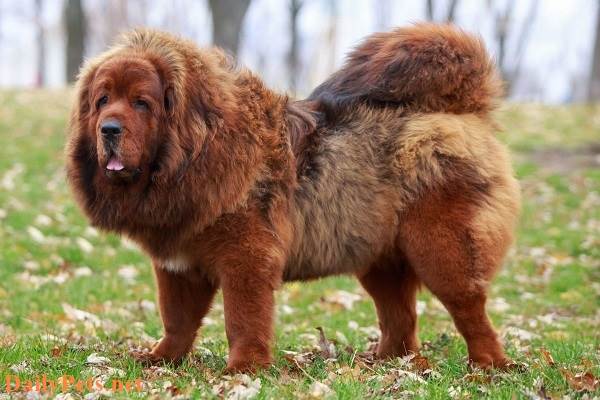Let’s learn about this dog breed with DailyPets.net!
Learn about the Pekingese breed
Origin of Pekingese Dogs
From the name Pekingese, everyone knows that this breed originated in China. This is the oldest known dog breed in China and a noble breed that appears in many royal circles. The symbol of the Pekingese dog from ancient times is to ward off evil spirits and bring good luck to people.
In 1860, Britain invaded China, and the destruction of Pekingese dogs began there. Only one living dog was brought to the UK and put on show. Since then, the Pekingese dog has been widely bred and has become a familiar name in the pet world in many countries around the world.
Pekingese dog appearance characteristics
Pekingese dogs have very small bodies compared to other breeds, but their bodies are quite strong and toned. Adult dogs are usually only about 15cm – 25cm tall and weigh about 9kg – 12kg. The body length is slightly higher than the height, but it doesn’t look too different.
The face of the Pekingese is broken, and the muzzle is wide. The nose is black, wide, and short. The big, round, slightly protruding black eyes look quite adorable. The ears are slightly drooping below. The neck is also quite short. The long, curved tail and ruffled fur curl up the front.

Pekingese Dog.
The coat of the Pekingese is ruffled and dense, covering the whole body. In particular, the coat of this breed is also divided into 2 layers, the outer layer is rough and long, and the inner layer is fluff, so it is softer. The common coat color of the Pekingese is white or golden brown.
Pekingese dog classification
Pekingese dogs can be divided into purebred Pekingese and hybrid Pekingese. Pekingese hybrids include Pekingese with Japanese hybrids, Pekingese with squirrels, or Pekingese with poodles.
Pekingese dog personality traits
The Pekingese is very strong and independent despite its small body. They always complete the task of keeping the house safe, ready to face danger to protect the owner.
This cute and obedient dog loves to cuddle with its owner. Sometimes they are naughty and stubborn, so you need to be patient with them. But in general, this is a dog that obeys its owner.
The Pekingese dogs can make friends with other Pekingese dogs but take time to get used to other animals. So don’t get them close too quickly, but give them time to get used to them.
The Pekingese dogs have understanding and sharing with their owners. They often lie in their owners’ laps to comfort and comfort them when they see their owners sad.
How to care for a Pekingese dog
Pekingese dog food
Pekingese dog food includes rice and side dishes such as meat, bones, and vegetables. You should provide enough nutrients for them to grow fast and healthy and calcium to develop bones and muscles. In addition, you should also feed the Pekingese with vegetables and fruits so they have a long and smooth coat.
Pekingese dog’s diet by stage
- From 1-2 months old: feed Pekingese soft foods such as porridge or pureed rice. You should divide it into several meals and each meal with the right amount of food. You must ensure hygiene so there are no bad cases because their stomachs are immature.
- From 3 to 6 months old: at this age, you can give Pekingese dogs a variety of foods such as meat, bones, fruits, vegetables, etc. For bones, you should avoid giving them easily hollow bones such as bones tube and should be watched so as not to cause danger to the throat and stomach.
- From 6 months old and up: this is the age of adulthood, so you need to feed 3 meals a day and increase the amount of food. You need to ensure that you provide enough nutrients, such as protein, calcium, vitamins, etc., to ensure the baby’s best development.
How to care for and hygiene for Pekingese dogs
- Brush the Pekingese once a day to remove loose hair. You can trim your Pekingese when it’s hot to make them more comfortable.
- Pekingese have a dense coat that covers the whole body, so it will be a bit difficult to wash, but you should still bathe them every 1-2 weeks to avoid odors and skin diseases.
- Clean the Pekingese’s ears, eyes, and feet regularly.
- Trim nails every week and brush your teeth regularly with pet toothpaste for good health and fresh breath.
Common Pekingese Dog health problems
- Because of their long hair, they are prone to skin diseases if they are not cleaned properly. So you should carefully wash them once in 1-2 weeks.
- Small dogs are often prone to dislocation of the patella, causing them to limp. This is a congenital disease.
- The skin of the Pekingese dog has folds, so it is easy to get fold dermatitis. Symptoms of this disease are red, sore, and foul-smelling skin. If your dog has the above signs, you should immediately take them to the veterinarian!
Notes when caring for Pekingese dogs
- This is a rather stubborn breed, so when training them, you need to be patient and decisive even when they are young. If your pet can only stay indoors, you should take time to walk them for at least 30 minutes to 1 hour a day to relieve the urge to go for a walk and give them a sense of comfort after a day in the house secret house.
- Pekingese dogs must be vaccinated and dewormed fully regularly. Don’t forget to check your pet’s vet every 6 or 12 months.
- Pekingese dogs should only be purchased at reputable addresses, without genetic problems, and only brought home when vaccinated with 2 doses of vaccines.





